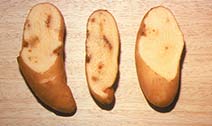Boron deficiency in potatoes

Boron is essential for the health and quality of potatoes. The potato cooking quality may be compromised when the tubers have a boron deficiency. Fertilizing potatoes with adequate boron is necessary for:
- Movement of calcium throughout the plant for correct calcium nutrition
- Uniformity of cell type
- Increased vitamin C concentration, which boosts nutrition
- Yield and overall quality
Symptoms of boron deficiency in potatoes are seldom seen on the shoot, although reduced growth with short internodes and curled leaves have been reported. Symptoms are more readily seen in the tubers in the form of brown necrotic patches. The condition known as “internal rust spot” is responsive to application of boron fertilizers, but it is yet to be proven whether it's due to boron deficiency or only an indirect association with boron.
Reducing boron deficiency
Soil sampling and potato petiole and leaf analysis are crucial to determining if your potatoes are receiving adequate boron.
If boron fertilizers are applied in the first 14-30 days after tuber initiation, when potato cells are just beginning to divide, there is better uniformity of cell type.
Your boron fertilizer options
These fertilizers work best for potatoes:
- Granubor® is an ideal material for dry-blend fertilizers applied broadcast preplant or surface banded
- Fertibor® works best in fertilizer suspensions for preplant broadcast or band sprayed over the row
- Solubor® allows you the most flexibility for applying boron fertilizer. It can be dissolved alone in water or in liquid fertilizers and/or pesticides, then applied to the soil or directly onto the foliage*
- Solubor has been found most effective when used as a foliar spray, 40 to 60 days after planting
Typical recommended ranges for boron boradcast soil application for potatoes is 0.5-1 lbs of B/acre. Normal plant analysis levels for the best quality and marketability have leaf boron levels in the 20-40 ppm range.**
Using boron fertilizers on potatoes helps growers improve the quality of the crop—and their ROI.
* Foliar sprays should not exceed 0.5 lb/acre boron per application.
**Always consult local crop advisors to check the proper dose rates. Rates of boron fertilization should be based on yield goals along with soil tests and/or plant tissue analyses.